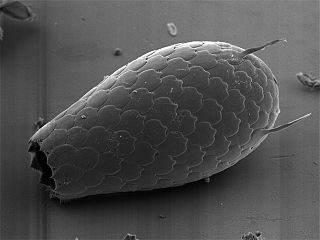
The alveolates are a group of protists, considered a major clade and superphylum within Eukarya. They are currently grouped with the stramenopiles and Rhizaria among the protists with tubulocristate mitochondria into the SAR supergroup.

Cercozoa is a phylum of diverse single-celled eukaryotes. They lack shared morphological characteristics at the microscopic level, and are instead united by molecular phylogenies of rRNA and actin or polyubiquitin. They were the first major eukaryotic group to be recognized mainly through molecular phylogenies. They are the natural predators of many species of bacteria. They are closely related to the phylum Retaria, comprising amoeboids that usually have complex shells, and together form a supergroup called Rhizaria.

Cercomonads are small amoeboflagellates, widespread in aqueous habitats and common in soils.
Reticulosida is an order of Cercozoa that was created by Cavalier-Smith in 2003, but subsequently emended in by Bass et al. in 2009 to include only one monotypic family, the Filoretidae.

Monadofilosa is a grouping of Cercozoa. These organisms are single-celled amoeboid protists.

Myzozoa is a grouping of specific phyla within Alveolata, that either feed through myzocytosis, or were ancestrally capable of feeding through myzocytosis.

Holozoa is a clade of organisms that includes animals and their closest single-celled relatives, but excludes fungi and all other organisms. Together they amount to more than 1.5 million species of purely heterotrophic organisms, including around 300 unicellular species. It consists of various subgroups, namely Metazoa and the protists Choanoflagellata, Filasterea, Pluriformea and Ichthyosporea. Along with fungi and some other groups, Holozoa is part of the Opisthokonta, a supergroup of eukaryotes. Choanofila was previously used as the name for a group similar in composition to Holozoa, but its usage is discouraged now because it excludes animals and is therefore paraphyletic.
Thaumatomonas is a genus within Imbricatea of the phylum Cercozoa.

The sarcomonads or class Sarcomonadea are a group of amoeboid biciliate protists in the phylum Cercozoa. They are characterized by a propensity to move through gliding on their posterior cilium or through filopodia, a lack of scales or external theca, a soft cell surface without obvious cortical filamentous or membranous skeleton, two cilia without scales or hairs, tubular mitochondrial cristae, near-spherical extrusomes, and a microbody attached to the nucleus.
Massisteria is a genus of Cercozoa. They are naked protists with a central cell body from which several delicately thin and stiff pseudopodia extend, each one bearing a small number of granules. Their pseudopodia remain adhered to the substrate, as is typical among leucodictyids. The cell body has two flagella that, during feeding, are held in place.

The apusomonads are a group of protozoan zooflagellates that glide on surfaces, and mostly consume prokaryotes. They are of particular evolutionary interest because they appear to be the sister group to the Opisthokonts, the clade that includes both animals and fungi. Together with the Breviatea, these form the Obazoa clade.

A protist is any eukaryotic organism that is not an animal, plant, or fungus. The protists do not form a natural group, or clade, since they exclude certain eukaryotes with whom they share a common ancestor; but, like algae or invertebrates, the grouping is used for convenience. In some systems of biological classification, such as the popular five-kingdom scheme proposed by Robert Whittaker in 1969, the protists make up a kingdom called Protista, composed of "organisms which are unicellular or unicellular-colonial and which form no tissues". In the 21st century, the classification shifted toward a two-kingdom system of protists: Chromista and Protozoa.

Cryptista is a clade of alga-like eukaryotes. It is most likely related to Archaeplastida which includes plants and many algae, within the larger group Diaphoretickes.
Endohelea is a proposed clade of eukaryotes that are related to Archaeplastida and the SAR supergroup. They used to be considered heliozoans, but phylogenetically they belong to a group of microorganisms known as Cryptista.
Ancoracysta is a genus of eukaryotic microbes containing the species Ancoracysta twista, a predatory protist that appears to be related to Haptista.
Neocercomonas is a protist genus of the order Cercomonadida. It consists of single-celled bacteriophagous organisms that usually live on or nearby terrestrial plants, both above and belowground. Species are biflagellate and may grow up to 60 micrometers long, with a trailing tail-like mass of protoplasm at their posterior end and a pair of roots connecting their posterior flagellum to the cytoskeleton.
The paracercomonads are a group of cercozoan protists. Taxonomically, they comprise the family Paracercomonadidae, order Paracercomonadida and subclass Paracercomonada. Due to their morphological similarities to the cercomonads, members of this family were grouped with Cercomonas and similar taxa from the beginning. However, their similarities are due to convergent evolution.

Ventrifilosa is a highly diverse group of phagotrophic protists that glide through their flagella and emit filose pseudopods from their ventral side for feeding. Because of their mixture of amoeba and flagellate characteristics, they are amoeboflagellates. Members of this group are the Imbricatea, Sarcomonadea and Thecofilosea.

Gyrista is a phylum of heterokont protists containing three diverse groups: the mostly photosynthetic Ochrophyta, the parasitic Pseudofungi, and the recently described group of nanoflagellates known as Bigyromonada. Members of this phylum are characterized by the presence of a helix or a double helix/ring system in the ciliary transition region.
Massisteriidae is a family of granofilosean protists within the phylum Cercozoa.








